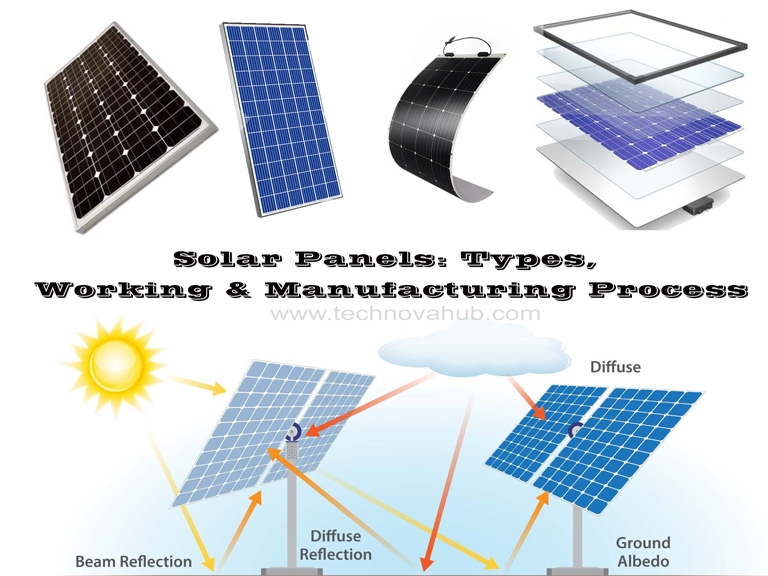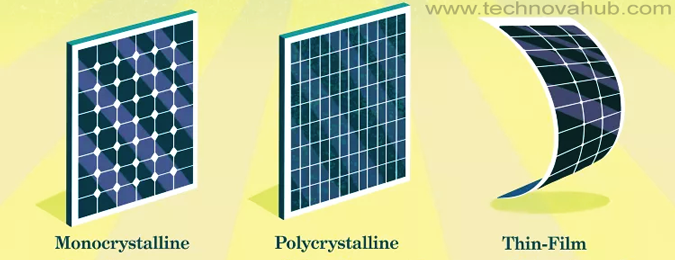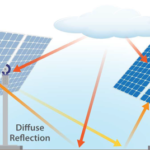Business
Solar Panels: 3 Types, Working & Manufacturing Process

Solar panels are used to generate electricity by solar energy. Solar panels are a combined formation of solar cells. Solar cells (PV cells) are first developed in 1954, in the United States when Daryl Chapin, Calvin Fuller, and Gerald Pearson at Bell Labs.
The invention of solar cells is a great success in future energy sources for the world.
The main source of solar energy is SUN, which is always available, so solar energy is always available without any other environmental or natural resource disturbance. Solar doesn’t harmful to the environment so it is a Green Energy Resource of energy.
Here we will discuss Only Solar panels. Mainly, the working Process, Types of solar panels, the manufacturing process of solar Panels, and available manufacturing companies in India.
Table of Contents
Working Process of Solar cell
A solar cell, also known as a photovoltaic cell, is a device that converts light energy directly into electrical energy. Here is the working process of a solar cell:
The solar cell is made up of semiconductor material, such as silicon, that is designed to absorb photons of sunlight. When sunlight hits the solar cell, the photons are absorbed, exciting the electrons in the semiconductor material.
The excited electrons in the semiconductor material are then able to move freely within the material, creating an electric current.
The electric current generated by the excited electrons is due to the separation of electrons and holes. Holes are the absence of electrons in the semiconductor material. When a photon of sunlight is absorbed, an electron is excited from its normal position and leaves behind a hole.
The solar cell has an electric field that pushes the free electrons toward the top of the cell, while the holes are pushed toward the bottom. This results in the generation of a voltage difference between the top and bottom of the cell, creating an electric potential.
The electric potential generated by the solar cell can be used to power electrical devices or it can be stored in a battery for later use.
A solar cell works by absorbing photons of sunlight and converting the energy into an electric current through the separation of electrons and holes in a semiconductor material.
Manufacturing Process of Solar Cell

The solar cell is made up of a semiconductor material silicon.
First of all, silica sand (Silicon dioxide) is used to extract the Silicon. By the way, Silica is the second most available material on the earth’s crust. Sand with coal melted at 2000 degrees Celsius results in metallurgical-grade silicon with 99% purity. When it solidifies it transforms into a shiny crystal solid.

For the Purity of Silicon further, Liquify the silicon and cleaning by distillation it and depositing it onto a silicon seed sample. Since it is a very difficult process so for this process transformation of everywhere available soil on the earth’s crust into Silicon very heavy and difficult types of machinery requires.
It is deposited into bars and in the next step broken into slices.
Further for the flow of electrons, increase the surface area of the slice top area, development of P-N junction, and collection of electrons next steps done.
Aluminum/Boron in the downward layer and phosphorus in the upper side of the silicon slice are added for the formation of electrons. This process of adding aluminum and phosphorus is called Doping. As result, two different layers are created and in middle, a resistance wall creates which is called the Depletion zone.
by applying a layer of phosphorous to one side of the silicon wafer, and a layer of boron to the other side. This creates a positive and negative charge, which is necessary for the cell to generate electricity when exposed to sunlight.
Manufacturing Process of Solar Panels
A combination of solar cells makes Solar panels.
For Solar Panel manufacturing some manufacturers who start with low investment can purchase Solar cells and by assembling and framing them can be manufacturers of Solar Panels.
Once the solar cells have been created, they are interconnected using metal conductors to form a solar panel. This involves soldering metal ribbons to the top and bottom of each cell and then connecting them together.
The solar cells are then placed between two sheets of glass and sealed with a special adhesive. This creates a protective layer that helps to prevent damage to the cells from weather, moisture, and other environmental factors.
The final step is to assemble the frame for the solar panel. This involves attaching the glass and encapsulated solar cells to a metal frame, which provides support and protection for the panel
Now solar panel has been assembled, it is ready to be tested and then installed for use in a solar energy system.

Types of Solar Panels
Solar panels can be classified mainly three types based on efficiency and type of solar cell material used:
- Monocrystalline Solar Panels
- Polycrystalline Solar Panels
- Thin-Film Solar Panels

1. Monocrystalline Solar Panels:
These are made from a single crystal of high-purity silicon, and they are the most efficient type of solar panel. They are also the most expensive to produce solar power. Monocrystalline solar panels are recognizable by their dark, uniform appearance. Solar cells’ shape will not be actually rectangular but all four-corner cut down. It has a maximum efficiency of electricity production. This kind of solar panel can produce electricity in low sunlight or in the cloudy day also.
2. Polycrystalline Solar Panels:
These are made from multiple fragments of silicon melted together to form a single panel. They are less expensive to produce than monocrystalline panels, but they are also slightly less efficient. Polycrystalline solar panels are recognizable by their blue-speckled appearance. Solar cells be rectangular in shape. The efficiency of this kind of solar panel is low compared to Monocrystalline solar panels. It needs high sun rays to produce electricity.
3. Thin-Film Solar Panels:
These are made by depositing layers of semiconductor materials onto a substrate, such as glass or plastic. They are the least expensive to produce, but they are also the least efficient. Thin-film solar panels are recognizable by their uniform, matte appearance and can come in different types including Cadmium Telluride (CdTe), Copper Indium Gallium Selenide (CIGS), and Amorphous Silicon (a-Si). Less used products due to less energy production in large-size solar power plants.
Some other Important Terms:
1. Solar Cell
A solar cell, also known as a photovoltaic cell, is a device that converts sunlight into electricity by the photovoltaic effect. It consists of a thin semiconductor wafer, usually made of silicon, which absorbs photons of light and releases electrons, generating an electric current. Output of one PV cell is approx 0.5V.
2. Solar Module
A solar module is a collection of interconnected solar cells that work together to generate electrical power. The module is enclosed in a protective casing and is designed to withstand outdoor conditions. Generally, 72 cells make a solar module whose output will be 32V.
3. Solar Panel
A solar panel is a flat or angled collection of solar modules that are mounted together on a frame. The panels can be used to generate electricity for a variety of applications, including homes, businesses, and remote locations.
4. Array
A solar array is a collection of multiple solar panels that are connected together to generate electricity. The panels in an array are typically installed on a rooftop or on the ground in a sunny location.
5. Solar Park
A solar park is a large-scale solar power plant that uses a collection of solar panels or arrays to generate electricity. Solar parks can be located in remote areas or integrated into urban environments and can provide electricity to large numbers of homes and businesses.
Biggest Solar Park in World
- Bhadla Solar Park, India (2,245 MW)
- Huanghe Hydropower Hainan Solar Park, China (2,200 MW)
- Pavagada Solar Park, India (2,050 MW)
- Benban Solar Park, Egypt (1,650 MW)
- Tengger Desert Solar Park, China (1,547 MW)
Read Also: Solar Energy: Classification, Components, Advantages, & Disadvantages
What are portable solar panels?
Portable solar panels are small, lightweight solar panels that are designed to be easily transported and used on the go.
They typically consist of a set of solar cells mounted on a flexible or foldable substrate, which can be easily rolled up or folded for storage and transportation.
Portable solar panels are used to generate electricity in remote locations where access to grid electricity is limited or non-existent.
They are commonly used for camping, hiking, and other outdoor activities, as well as for emergency preparedness and disaster relief efforts.
Portable solar panels are available in a variety of sizes and configurations, ranging from small panels that can be used to charge mobile phones and other small devices, to larger panels that can power RVs or boats.
They are often paired with portable battery packs, which can store the electricity generated by the panels for later use.
Portable solar panels are a sustainable and eco-friendly alternative to traditional fuel-powered generators, and they offer the added benefit of being silent and emission-free. They can also help reduce reliance on fossil fuels and decrease carbon emissions.
What are Bifacial Solar Panels?

Bifacial solar panels are a type of solar panel that can generate electricity from both sides of the panel.
They have a transparent back sheet that allows sunlight to pass through to the backside of the solar cells, which can then generate electricity from the reflected and scattered light.
Bifacial solar panels can offer higher energy yields compared to traditional solar panels because they are able to generate electricity from both direct and diffuse sunlight.
Bifacial solar panels are made using similar materials and manufacturing processes as traditional solar panels. However, they typically have a higher upfront cost due to their additional features and increased complexity. Bifacial solar panels can be installed in a similar way to traditional solar panels, either mounted on rooftops or on the ground in solar arrays.
Bifacial solar panels are particularly well-suited for installation in areas with a high albedo, which refers to the reflectivity of the surrounding surfaces.
This includes areas with white or reflective rooftops, snow-covered surfaces, or bodies of water. Bifacial solar panels can also be installed in single-axis or dual-axis tracking systems, which can further increase their energy yield.
How many solar panels do I need?
The number of solar panels you need depends on your consumption of energy and many other factors.
Basically, Look at your energy bills to determine your average daily and monthly energy consumption in kilowatt-hours (kWh).
A typical residential solar system is between 3 kW and 8 kW.
The number of solar panels required will depend on the wattage of the solar panels you plan to use.
For example, a 300-watt solar panel will produce 300 watts of power per hour, and a 5-kW system will require approximately 16-17 solar panels of this size.







